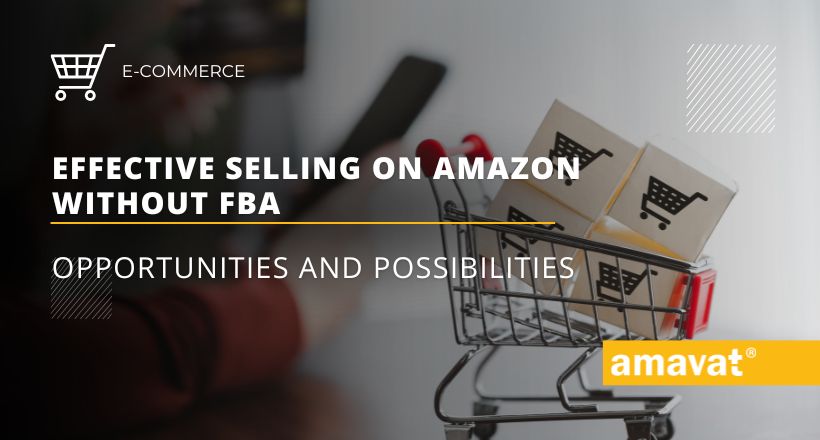Effective selling on Amazon without FBA: Opportunities and possibilities
Have you ever considered selling on Amazon without FBA? This solution is entirely feasible and can be a viable option for many sellers. The main advantage is greater control over the order fulfillment process and direct interaction with customers. However, careful management of inventory, shipping, and customer service is crucial.
Before deciding whether to sell on Amazon without FBA, it is essential to thoroughly understand the options available on the platform. Amazon offers two basic fulfillment models: FBA and FBM.
What is Amazon FBA and what are the costs involved?
FBA (Fulfillment by Amazon) is a solution where the seller sends products to one of Amazon’s robotic logistics centers and entrusts them with order processing.
In the FBA model, Amazon is responsible for storage, packaging, shipping of goods, and customer service. The seller gains assurance that all messages from buyers will be handled promptly. Rapid order fulfillment, which operates 24/7, is another advantage of the FBA model. This allows entrepreneurs to avoid increasing internal operational capacity. Any returns will also be processed without the seller’s involvement—the Amazon team will handle it.
Fulfillment by Amazon comes with two types of fees. Standard fees include:
- Storage costs
- Shipping costs
However, Amazon’s fulfillment centers offer a much broader range of services, including long-term storage of goods and inventory disposal. The amount of fees depends, among other factors, on the country of distribution.
What is Amazon FBM?
FBM (Fulfillment by Merchant) is a system in which the seller bears full responsibility for storing, packaging, shipping, and processing returns of goods. Unlike the FBA model, the seller must also handle customer service.
The FBM solution is suitable for beginner sellers whose product portfolio is not yet established, and who may doubt whether they will be well-received by Amazon customers.
Considerations for selling on Amazon without FBA
According to data from the 2022 Amazon Seller Report by SellerApp, a significant majority—71%—of Amazon sellers use the FBA model, while 19% have chosen a hybrid solution. However, there is a percentage of sellers who have decided to sell without utilizing Amazon’s warehouses.
How to start selling on Amazon without FBA?
Start by creating a seller account and setting up your FBM product listings.
- Create an Amazon seller account: On the Amazon Seller Central page, click “Register” and proceed through the steps to fill in information such as company name, address, contact details, and bank account information. Make sure to select the Fulfillment by Merchant option during registration.
- Verify your identity: Amazon will ask you to provide documents confirming your business details, address, and bank information.
- Set up your seller profile: The next step is configuring your seller profile, where you need to specify return policies, shipping options, and customer service contact details. It’s advisable to ensure the accuracy of the information provided.
- Add product listings: In the Amazon Seller Central panel, you can search for existing product listings or create new ones. To do this, go to the “Inventory” tab and click “Add Product.” Fill in detailed information about your products, including title, description, images, price, and other relevant information.
- Choose FBM as the default model: When creating or editing product listings, remember to select FBM as the fulfillment method. This means you will take care of storage, packaging, and shipping of the products.
- Enter shipping settings: Specify shipping methods, rates, and regions you will serve. You can use Amazon’s shipping templates to simplify this process and ensure consistency in your offers.
Cost calculation and profitability of selling on Amazon without FBA
Before deciding to sell on Amazon without FBA, it is important to be aware of the associated costs and assess potential profitability. Key factors to consider include:
- Costs of purchasing or producing products, including any packaging materials
- Shipping costs, which depend on the size and weight of products, as well as destination addresses
- Costs of maintaining warehouses
- Costs of picking, packing, and shipping orders
- Amazon fees—while you won’t incur FBA fees, Amazon charges various other fees for selling on its platform
- Sales volume—analyze sales forecasts to estimate potential revenues and determine whether profitability exceeds costs.
Calculating these costs will allow you to assess the potential profitability of sales, enabling you to make an informed decision on whether selling on Amazon without FBA is worthwhile for your business.
Selling without FBA – What to keep in mind
Managing logistics independently on Amazon involves several actions to keep in mind. Below are areas that every seller should pay particular attention to:
- Pricing policy: Conduct research and analyze market prices to set competitive prices for your products.
- Listings: Ensure that photos and descriptions are accurate and include all necessary information for customers to make informed decisions. Optimize your product listings with relevant keywords, clear titles, and bullet points to improve search rankings and visibility on the platform.
- Shipping: Ship orders on time and provide customers with tracking information. Fast and reliable delivery increases customer satisfaction.
- Customer service: Respond to customer inquiries and resolve any issues promptly. Positive reviews and satisfied customers can lead to increased sales, so regularly monitor feedback and reviews of products sold.
- Inventory: Efficient inventory management will help avoid over-selling or stockouts. Use tools or software to manage your inventory processes effectively.
- Packaging: Use quality materials and always ensure that products are properly secured during shipping.
- Advertising: Utilize Amazon’s advertising options to increase product visibility and traffic to your listings.
- Technology: Leverage software and tools integrated with Amazon to automate certain parts of the order fulfillment process.
Summary
Before choosing a logistics model for your business and deciding whether to sell on Amazon without FBA, consider all advantages and disadvantages, assess costs and profitability, and explore alternative fulfillment options. A suitable strategy and the implementation of best practices will enable you to successfully sell on Amazon without FBA and achieve your sales goals.






